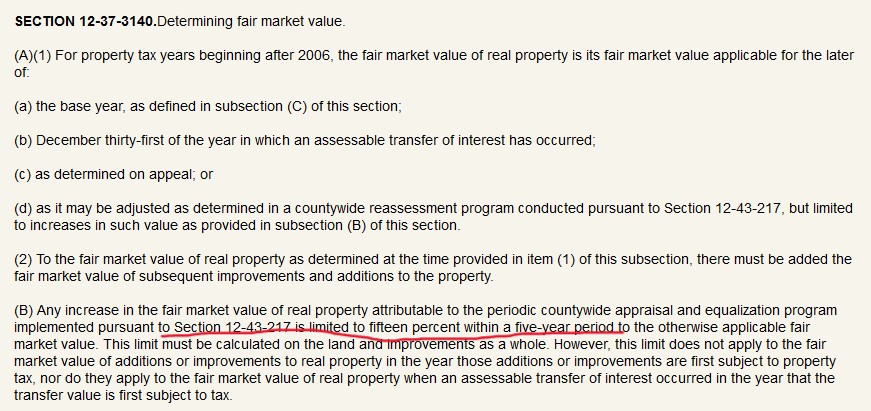Reassessment Year, Law & Valuations
By Alex Saitta
January 16, 2025
Reassessment:
By state law every county in the state has to reassess the value of each property. This year, 2025, is the next reassessment in Pickens County. Valuations change over time, so the purpose of the reassessment is to determine real property market values that are in line with current property characteristics and market conditions.
Rollback:
Most existing properties will rise in value over the 5 years. There is a state law that forbids the county from gaining a windfall from higher reassessments, so by law the property tax rate must be rolled back accordingly.
In 2019, I wrote about this rollback process in detail and you can read about it here if youíd like. Click write-ups and see the Feb 10, 2020 write-up.
For example, if the overall assessed value of all the property in the county rises an average of 15%, the tax rate will be cut or rolled back by about that much. The county, cities and school district are allowed extra revenue in a reassessment year for annual inflation and the new homes built, so likely the tax rate will be rolled back about 11 to 12% in our example.
These are averages and for this or that property, there will be variation around the average. As a result, some may see a small increase in their tax bill from reassessment, others little change, and still others will see a decrease in their tax bill. I know there are a lot of shenanigans that goes on during reassessment years as this or that taxing entity tries to game the system to pick up more revenue, but that is what should happen in theory.
Reassessment Cap:
The state law also says in reassessment years assessed values can only be raised by 15%. This is the reason the 5 -year reassessments have been milder than past few cycles, However, this cap, which has been in place now about 20 years is starting to skew valuations and tax bills. Let me explain.
Letís say you live in a subdivision, in a 3 BR/ 2 BA home, built in 2004 and it is 1,425 sqf. By the way, Iím looking at a particular home in Liberty, itís tax records are on line. This home is now assessed at $117,000. This upcoming reassessment the assessed value can only be increased by 15%, so the new assessed value will be $134,500. In reality, that home is worth about $250,000 today. Thatís a windfall if you live in the home and stay in the home.
Resales:
However, under the state law, the cap does NOT apply when a house is resold. Then the new assessment is set to the sales price. Sales prices have gone up way more than 15%, rather about 100% the past 5 years. Looking a houses down the same street, roughly the same home (same age, size and 3 BR/ 2 BA) one sold for $255,000 in 2023. That is what that home is assessed at on the tax records now.
When we calculate the property taxes of these two very similar owner occupied homes, the property tax bill of the first home will be about $775. The second home the taxes will be about $1,500. It has nothing to do with the reassessment year being in 2025, but rather the state law that caps reassessed values of homes that are not sold at 15%, vs homes that are resold with no reassessment cap.
New Homes:
The 15% reassessment cap doesnít apply to newly constructed homes. In that subdivision, very near that first home, two new homes were recently built, very similar, but they sold for about $265,000. Those are assessed at $265,000, and naturally their tax bills are higher at $1,550.
Windfall To Local Gov:
Before there was a reassessment cap, during reassessment the average home would go up like 30%, so the tax millage rate would be rolled back like 20% (allowing for extra revenue to be had because of that year's housing growth and inflation -- that is allowed under the reassessment law).
The next year when a home was sold it would jump 5% from its assessed value. The higher assessed value times the much lower tax rate and the local governments reap a small amount of extra revenue due to the transaction.
Now with state reassessment cap and how much market rates have gone up, reassessed property values rise only 15%, so the millage rate is rolled back only 11 to 12%. That house is sold the next year, jumping up to its market value like 80% higher than its cap, so the new assessed value goes up that much. Now times that jump by the relatively higher tax rate (because the roll back is smaller with the cap) and local governments share in much more new tax revenue from the transaction.
Conclusion:
Iím not arguing for keeping the cap or not. The person that buys and holds his home benefits. Local government benefits. The person who buy a resale, is paying much more. No opinion put forth here. Iím just explaining what is occurring as I have not read this before. I think at some point there will be lawsuits, the courts will rule, and the state legislature will be forced to revisit this state law that caps reassessment values. Just look at the result that is slowly unfolding with each passing reassessment.
The stated purpose of the 5 year reassessment is to equalize properties and their valuations. The law currently in place, due to the cap, is doing just the opposite. It is un-equalizing very similar homes right next to each other, but have vastly different assessed values and tax bills.


